Dell UltraSharp 2408WFP Widescreen 24in LCD Monitor Review
Dell UltraSharp 2408WFP Widescreen 24in LCD Monitor
Can the highly connected Dell 2408WFP knock the BenQ FP241W from its solitary throne?
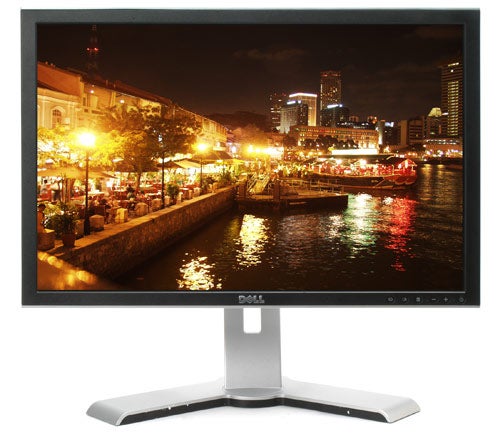
Verdict
Key Specifications
- Review Price: £387.75
For the advanced computer user, 24in monitors are probably the sweet spot right now, offering the ideal combination of price, resolution and desk space. WUXGA (1,920 x 1,200) resolutions are only just making their way into panel sizes below 23in (at least in desktop monitors; laptops like the Alienware Area51 m15x offer them below 17in), with most 22in monitors still only offering 1,680 x 1,050. The advantages of the higher resolution are not only that it gives you more working area, but it’s also ideal for displaying full HD (1080p) content.
Going above 24in, the dot pitch also goes up, meaning your images are no longer as sharp. Meanwhile, adjustability goes down, with only rare cases offering pivot or even height adjustment. Of course, taking things to the next level, you could go for a 30in screen, but these severely tax both your wallet and your graphics card, and use up to twice as much electricity. 
The 24in market itself can be roughly divided up into two segments: on the one hand we have the cheap and cheerful displays such as the BenQ G2400W, usually sporting TN panels, minimal inputs and almost no adjustability; on the other are more expensive monitors that use higher quality panels (sPVA/MVA or IPS) featuring potentially more accurate colours and better viewing angles. These usually offer the full range of ergonomic adjustments, and multiple inputs including USB, component and HDMI. An example of this type is the Samsung SyncMaster 245T.
While the former are adequate for ‘normal’ use and PC gaming, if you require colour accuracy, flexibility or the ability to hook up multiple consoles (especially the Wii, which needs component for the best quality), the latter segment will be for you. And in that case keep reading, because – on paper at least – Dell’s latest 2408WFP fulfils all these criteria and more.
In terms of physical design, anyone who is familiar with the previous 2407 will find themselves in well-known territory. But that’s by no means a bad thing, as the 2407 was among the better 24in designs of 2007. Of course, Dell has significantly updated some of its monitors’ looks with the UltraSharp 2707WFP, but personally, I’m glad the company kept the matte black bezel and sleek silver foot for its flagship 24incher. It’s one of those timeless looks that’s serious and attractive at the same time, and if it isn’t broke, why fix it?
Black simply is the only colour a monitor’s bezel should ever be, and matte instead of the frequent glossy finish means that, even though it might not look as appealing, there are no distractions from peripheral reflections. Thin silver strips on the top and bottom make the bezel seem even slimmer than it is, with the Dell logo and six small round buttons being the only detractions. Even the LED is unobtrusive, though this is the one area where I wish Dell had gone with the 2707’s blue, rather than the 24 series’ traditional green.
The stand, like the 2407’s before it, is one of the sleekest you’re likely to find on a 24in monitor, and the base also takes up less room than most, despite being heavy and solid. Build quality is good, though not quite as excellent as on some – the recently reviewed ViewSonic VP2250wb especially springs to mind.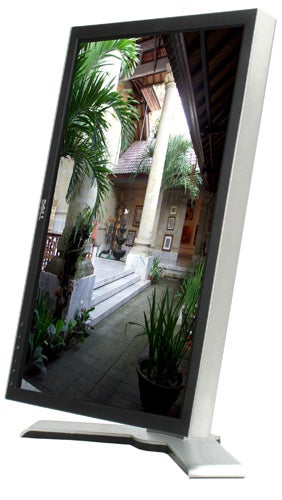
The monitor still comes in two parts, which are as easy to assemble as ever. Just click the stand into the panel chassis, and you’re ready to go. To disassemble, you merely press a small button on the monitor’s back and hey presto, the 2408WFP is ready for transport. Another advantage to the two-part design is that there is no holding-pin for the stand to lose.
Fortunately, the two piece design doesn’t have any detrimental effect on ergonomic adjustability either, with Dell’s 24in offering all the flexibility you could need or want. There is a large degree of tilt, and while it doesn’t allow you to go as high as the Hyundai W241D PVA, it goes far lower – almost down to your very desk. Of course, there is also pivot, allowing you to use the monitor in portrait mode (or even, thanks to the thin bezel, letting you put two pivoted screens next to each other).
So far, the 2408WFP is up there with the better monitors on the market, thanks to being virtually identical to the 2407. However, one area where Dell was lagging slightly behind some of the competition (like the BenQ FP241W) was in terms of inputs, especially the lack of HDMI. But boy, has it made up for that. Under the 2408WFP’s unassuming bezel hides a veritable plethora of inputs that would put even some high-end televisions to shame. 
Starting off the parade is a (for now) Dell monitor exclusive called DisplayPort. Vouched as a competitor or even eventual replacement for HDMI, it offers far greater bandwidth and supports higher resolutions, despite being only slightly bigger. Best of all though, it manages to avoid the licensing fees HDMI carries. So with all the advantages and none of the disadvantages, expect this to become popular quickly.
Naturally, HDMI is still included, allowing you to easily hook up a PlayStation 3 or newer Xbox 360. But don’t worry if you have both, as the 2408WFP provides no less than ”two” HDCP-enabled DVIs. Counting the DisplayPort (for which HDMI and DVI adaptors should be available), Dell has provided four usable digital connections, which really is as much as anyone is likely to need.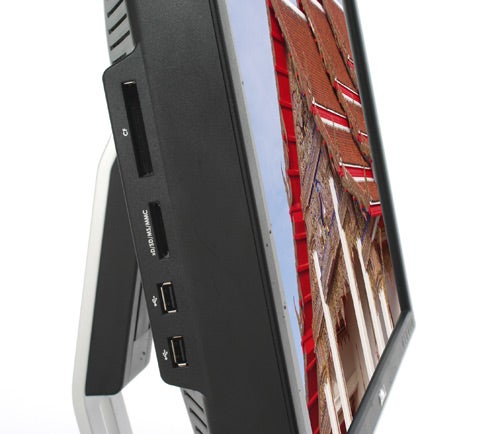
For the Wii owners out there, or those using older consoles, there is component, and trusty old analogue VGA is not left out. You also get S-Video and composite. But hang on, we’re far from done. There is a 3.5mm audio out (which unfortunately will only work for HDMI since there are no audio inputs). An integrated, powered four-port USB 2 hub means you can easily connect peripherals or charge gadgets, and the integrated media card reader should cater for most memory card types (CompactFlash, SD, MMC, xD, MemoryStick).
All of which makes the Dell easily the most accomplished monitor in terms of connections we have ever seen. The only extras one could possibly wish for at this stage might be a digital audio pass-through and a remote, since the 2408WFP could easily be used as a small full-HD TV.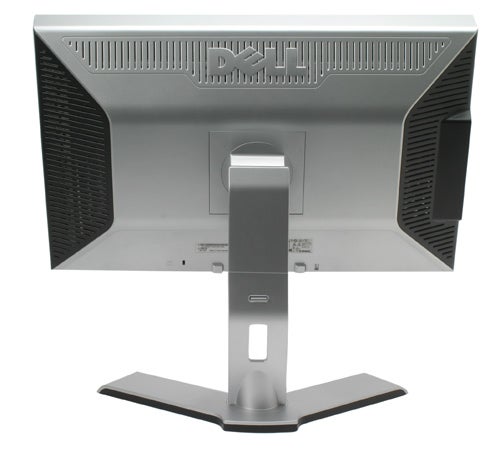
Moving onto the OSD, Dell’s menus are still beautifully presented, with colourful, clear icons, and the layout is fairly intuitive. However, it’s not quite as easy to use as some, mainly due to the lack of a dedicated back/exit-menu button. Apart from that, the OSD is a mixture of annoying and brilliant. For example, menus are dynamic, and change depending on input, but I cannot fathom why the second menu option in VGA is auto-adjust, when there is a dedicated button for this function – though it’s hardly fair to criticise Dell too much as it is not the only manufacturer guilty of this mistake.
Otherwise, options are very extensive indeed. There is a comprehensive selection of presets, including separate gamma and colour settings, and Desktop, Multimedia, Game, sRGB, Warm, Cool, and Custom RGB modes.
We also have all the adjustments you would want in a multi-purpose display, such as menu rotation (not automatic, like on the ViewSonic VP2250wb, but at least present), the option to disable the dynamic contrast (taking the monitor down from its backlight-controlled 3000:1 to a healthy native 1000:1 claimed figure), and an adequate selection of aspect settings. Essentially, there is 1:1 pixel mapping, meaning the monitor will display whatever you feed it exactly as is, and an Aspect mode that stretches content to the maximum possible without distortion. The only notable absence for a wide gamut monitor is the ability to switch off its overdrive.
Button layout is logical, and generally excellent. Amidst the touch-sensitive craze, Dell has stuck to physical buttons, and deserves further praise for featuring a dedicated ‘input select’ switch as its first one. Other shortcuts include PIP/PBP (unfortunately only on S-Video, composite and component) and contrast/brightness.
My main complaint with the buttons is ironically due to Dell’s prolific inputs, as from the original 2405‘s five we have gone to eight on Dell’s latest, and it would be nice to have an extra ‘previous input’ button, rather than having to cycle through the whole list every time. Though at least, as with BenQ’s stunning V2400W, switching is near instantaneous. 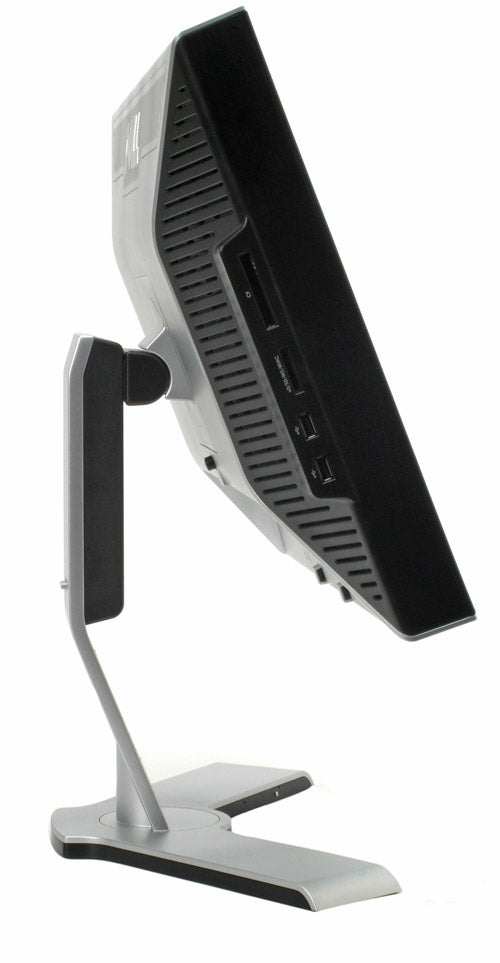
However, what really makes or breaks a display is image quality. Dell actually has an unusual and interesting policy when it comes to the quality produced by its panels. When a new model is released, if major downsides are noted by a large percentage of users (like the colour banding on the 2407FPW), Dell often brings out a new revision where it tries to fix the issue.
The panel inside the 2408WFP is actually an S-PVA, which should offer a combination of broad viewing angles, fairly accurate colours and decent response. Specifically, Dell claims a fairly standard 178 degrees for the viewing angles and 6ms grey-to-grey response. It also means this is a proper 8-bit panel, which can display the full 16.7 million colours without dithering. The 2408WFP features an even wider gamut than the 2407WFP-HC before it, covering 102 per cent of NTSC thanks to an enhanced seven tube W-CCFL backlighting system.
Starting off with backlighting performance, there is moderate bleed from all bezel edges, but it is still among the best I have seen on a 24in panel. Lighting is quite even across the panel (stronger towards the left corners), although this seems somewhat subjective: while viewing angles on PVA screens are generally good, they can suffer from contrast shift, and this is definitely a problem with the Dell. It’s a shame, as it means people who do colour intensive work, such as graphics professionals, will want to look elsewhere (IPS is still the superior panel technology in this respect). But keep in mind that for the average user, the 2408WFP’s viewing angles are more than adequate – certainly better than almost all TNs.
Nor is colour accuracy particularly good out of the box, though some extensive tweaking will remedy this to an extent. Once adjusted, the Dell’s colour performance is in line with other PVA monitors – which is a pity, as I expected more from the enhanced wide gamut. Still, the 2408WFP managed to resolve our greyscale tests with ease, showing deep blacks and pure whites simultaneously (marred only by the previously mentioned contrast shift). Colour gradations are also good, though there is some slight banding in darker tones.
For movies and multimedia, the 2408WFP is first rate, though no monitor yet can match the processing and quality of the better LCD TVs. It does not feature a glossy coating, but neither is it as matte as some, and there may be distracting reflections in dark scenes. However, the movie preset is effectively calibrated, and dynamic contrast works well enough that you’ll want to turn it on for film material. It is by no means the revolutionary system seen in the recently reviewed LG Flatron L206WU, but despite mainly just darkening the picture, it still makes movies more ‘film-like’ – especially by muting slightly over-saturated skin tones. Furthermore, black levels are excellent throughout, bearing out the 1000:1 native contrast figure.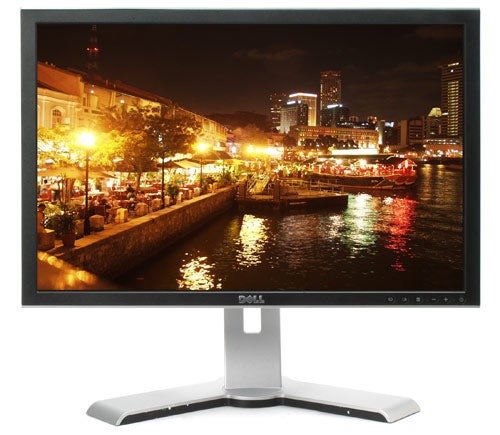
Gaming displays some barely noticeable tearing, but is otherwise a pleasant and vivid experience. Casual gamers especially will love the 2408WFP – also thanks to some decent interpolation allowing you to play at resolutions below native. Hooking up an Xbox 360 over component showed off just how pretty Ninja Gaiden 2 is, thanks to a clean and vibrant 1:1 signal.
For office use, meanwhile, Dell’s 2408WFP is largely ideal. There is only one minor caveat, which is that smaller text is less legible than on most 24in models, and we noted red aberrations showing up in white text against a black background at anything below 10 pixels. Also, annoyingly, the dynamic contrast function is not profile specific, so you have to remember to turn it off for anything but entertainment.
”’Verdict”’
In conclusion, we have a monitor that’s not suitable for graphics professionals, but most other people ought to be well pleased. The 2408WFP still has the same excellent ergonomics as its predecessor, offers reasonable image quality and more inputs than any other 24in monitor on the market. Especially as an entertianment device, Dell’s display earns good marks, and it’s all wrapped up in a stylish yet robust design. If Dell can sort out some of the issues with its A01 revision, due soon, this might even become the monitor that may come close to finally toppling the BenQ FP241W from its top spot.
Trusted Score
Score in detail
-
Image Quality 7
-
Design 9
-
Value 9
-
Features 10

